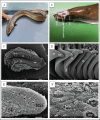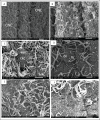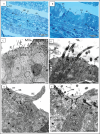Ultramicroscopic organization of the exterior olfactory organ in Anguilla vulgaris in relation to its spawning migration
- PMID: 38633152
- PMCID: PMC11018411
- DOI: 10.5455/OVJ.2024.v14.i1.46
Ultramicroscopic organization of the exterior olfactory organ in Anguilla vulgaris in relation to its spawning migration
Abstract
Background: Catadromous fishes have well-developed elongated olfactory organs with numerous lamellae and different types of receptor neurons related to their breeding migration.
Aim: The current study showed how the olfactory system adapted to the catadromous life. Our work declared the need of the migratory fishes for the sense of smell that is exhibited by a higher number of the olfactory lamellae and the receptor neuron verification in the olfactory epithelium.
Methods: Ten specimens of fully grown, but pre-matured, silver eels of Anguilla vulgaris were captured at the outlet of Edco Lake, overlooking the Mediterranean Sea, east of Alexandria. Olfactory rosettes were dissected and fixed for scanning electron microscope (SEM) and transmission electron microscope (TEM).
Results: Our study gave a morphological description of the olfactory system of A. vulgaris. At the ultrastructural level using SEM and TEM, one olfactory rosette was provided with 90-100 flat radial olfactory lamellae. The nasal configuration allowed water to enter and exit, transferring odorant molecules to olfactory receptor cells which comprise long cylindrical ciliated and microvillous receptors as well as rod-tipped cells. These cells are bipolar neurons with upward dendritic knobs. The olfactory epithelia also include crypt receptor cells. Interestingly, the olfactory neurons are delimited by nonsensory supporting cells, including long motile kinocilia and sustentacular supporting cells beside mucus secretory goblet cells and ionocytes or labyrinth cells that contribute to the olfaction process.
Conclusion: Olfaction is crucial in all vertebrates, including fishes as it involves reproduction, parental, feeding, defensive, schooling, and migration behaviors. Here, A. vulgaris is an excellent model for catadromous fishes. It has a well-developed olfactory organ to cope with the dramatic climate change, habitat loss, water pollution, and altered ocean currents effect during their catadromous life for reproduction.
Keywords: Anguilla vulgaris; Olfactory rosette; electron microscope; olfactory epithelium; olfactory receptors.
Conflict of interest statement
There is no conflict of interest, according to the authors.
Figures




Similar articles
-
Ultrastructural and developmental anatomy of the peripheral olfactory organs of Dicentrarchus labrax inhabiting Egyptian Mediterranean water.Open Vet J. 2025 Feb;15(2):939-953. doi: 10.5455/OVJ.2025.v15.i2.43. Epub 2025 Feb 28. Open Vet J. 2025. PMID: 40201804 Free PMC article.
-
Structural organization of the olfactory organ in an amphihaline migratory fish Hilsa, Tenualosa ilisha.Microsc Res Tech. 2018 Oct;81(10):1122-1131. doi: 10.1002/jemt.23095. Epub 2018 Sep 20. Microsc Res Tech. 2018. PMID: 30238561
-
Diversity in the olfactory epithelium of bony fishes: development, lamellar arrangement, sensory neuron cell types and transduction components.J Neurocytol. 2005 Sep;34(3-5):183-208. doi: 10.1007/s11068-005-8353-1. Epub 2006 Jul 13. J Neurocytol. 2005. PMID: 16841163
-
Olfaction in fish.Prog Neurobiol. 1975;5(4):271-335. doi: 10.1016/0301-0082(75)90014-3. Prog Neurobiol. 1975. PMID: 830087 Review.
-
Ecology and evolution of migration in the freshwater eels of the genus Anguilla Schrank, 1798.Heliyon. 2020 Oct 6;6(10):e05176. doi: 10.1016/j.heliyon.2020.e05176. eCollection 2020 Oct. Heliyon. 2020. PMID: 33083623 Free PMC article. Review.
Cited by
-
Ultrastructural and developmental anatomy of the peripheral olfactory organs of Dicentrarchus labrax inhabiting Egyptian Mediterranean water.Open Vet J. 2025 Feb;15(2):939-953. doi: 10.5455/OVJ.2025.v15.i2.43. Epub 2025 Feb 28. Open Vet J. 2025. PMID: 40201804 Free PMC article.
References
-
- Aicardi S, Bozzo M, Amaroli A, Gallus L, Risso B, Carlig E, Di Blasi D, Vacchi M, Ghigliotti L, Ferrando S. The arrangement of the peripheral olfactory system of Pleuragramma antarcticum: a well-exploited small sensor, an aided water flow, and a prominent effort in primary signal elaboration. Animals. 2022;12:663. - PMC - PubMed
-
- Atta K. Morphological, anatomical and histological studies on the olfactory organs and eyes of teleost fish: Anguilla anguilla in relation to its feeding habits. J. Basic. Appl. Zool. 2013;66:101–108.
-
- Axel R. Scents and sensibility: a molecular logic of olfactory perception (Nobel lecture) Angew. Chem. Int. Ed. Engl. 2005;44:6110–6127. - PubMed
MeSH terms
LinkOut - more resources
Full Text Sources
